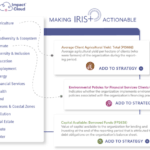Three Key Insights from GIIN Report on the Power of Capacity Building in Impact Investing
Impact investors seek to achieve meaningful positive change through their investments, including greatly improving the quality of life of underserved people around the world, and ensuring a sustainable and healthy planet. These investors often work in challenging environments with untested business models. Capacity-building support, also known as technical assistance, is a vital tool used by many investors to complement their investments and expand and deepen their impact.
Capacity-building support is used to strengthen various aspects of an investee’s business operations or strategy. Such support may be provided pre- or post-investment and either directly by the investor or by a third party. For example, an impact investor may assist the investee in the recruitment of a CFO or other key hire, provide a consultant to solve a specific technical challenge or conduct social and environmental impact assessments.
The Global Impact Investing Network (GIIN) provides resources that fill knowledge gaps for impact investors and increase the scale and effectiveness of the industry. A majority of impact investors employ some form of capacity-building support, yet there are limited resources that highlight practices across the industry and that include detailed examples from a variety of investors. In the report, Beyond Investment: The Power of Capacity-Building Support, the GIIN illuminates current capacity-building practice and invites a discussion about how to elevate the future use of this important tool. Case studies of four investors selected to reflect a wide range of capacity building models – Acumen Fund, Business Partners International, Medical Credit Fund, and responsAbility Investments AG – provide real-life examples of how investors leverage, design, implement and fund capacity-building efforts. The report documents how capacity-building support can contribute to the impact that investors are able to achieve, and surfaces three key insights about the current state of capacity-building practice in impact investing:
- Capacity building is a versatile, widely applicable tool that offers direct benefits to both investors and investees. It addresses a range of needs including human resources development, impact targeting, measurement and reporting as well as technical and/or specialized support. The needs that investors address via capacity-building are a function of various factors, including business stage of investee, timing of support and investment instrument. When applied well, capacity building improves investor competitiveness, enhances business performance of investees, expands impact for beneficiaries and strengthens markets and sectors. Some investors use it for a wide-range of investee needs, while others focus on a few specific needs.
- There’s no single way to structure and deliver capacity-building support. Impact investors generally use a highly customized approach to design projects tailored to the needs and requirements of their investees, with key elements including staffing structure, funding model and mechanisms to monitor progress and ensure accountability. responsAbility Investments AG manages various technical assistance facilities, dedicated to its different investment strategies, such as climate finance and energy access. Within each facility, responsAbility uses a customized approach, in which the individual projects are tailored to the needs of each investee that receives capacity-building support. However, there are some investors that use a more standardized approach across their portfolio. For example, Acumen Fund uses a more standardized approach to administer capacity-building support to its investees, focusing on five core areas in which it has found that most early- and growth-stage investees need support.
- There’s benefit (and opportunity) to openly sharing lessons learned with others. Although the practice of providing capacity-building support has grown and evolved alongside impact investing, opportunities remain to maximize efficiencies. Impact investors that are experienced at providing capacity-building support should consider how they can work more closely with others to improve industry practices. This includes collaboration with donors to streamline fundraising and reporting, with other investors to share insights, and with service providers to structure creative and effective delivery models. The four case studies, along with examples from other investors throughout the report, highlight the depth of insight that current practitioners have gained from the field. Hopefully, this report can inspire others to share their stories and collaborate.
The practice of complementing investment capital with non-financial support is not unique to impact investing; conventional PE/VC investors do this as well. For impact investors, capacity-building support is one critical tool used to accelerate and deepen the changes that they seek in the world. By expanding its use and through more coordinated efforts, investors, donors, service providers and investees can strengthen the impact of impact investing, grow vibrant markets with thriving business communities, conserve and enhance our environment and improve the lives of the people who need it most.
Abhilash Mudaliar serves as research director at the Global Impact Investing Network.
Photo courtesy of Pearson Affordable Learning Fund (PALF).
- Categories
- Impact Assessment, Investing



